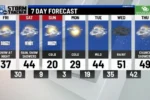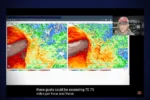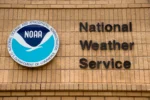Get ready, everyone! Severe storms are headed for the South today and tonight, bringing heavy rain and strong winds. Imagine pouring buckets of water over an already wet ground—that’s what could happen, with some places getting up to 5 inches of rain! This weather can cause dangerous flash floods and make it tricky to travel by car or plane. We’ll also need to be on the lookout for thunderstorms and even tornadoes. Let’s dive into what to expect and how to stay safe during this wild weather weekend!
| Category | Details |
|---|---|
| Severe Weather Impact | Severe storms are expected to impact the South today and tonight, and again this weekend. |
| Flash Flooding Risk | Areas may receive 3 to 5 inches of rain, with isolated areas potentially receiving more. |
| Travel Disruptions | Road and air travel are likely to be disrupted due to hazardous conditions. |
| Storm Development | Heavy rain and thunderstorms have started over the South, especially from East Texas to the Carolinas. |
| Area of Greatest Concern | Southeastern Texas to western Georgia has the highest risk of severe weather. |
| Tornado Risk | A high tornado threat exists from southeast Louisiana to central Alabama, including Hattiesburg and Montgomery. |
| Timing of Threats | The peak threat occurs during the afternoon and evening, with storms possibly continuing overnight. |
| Weekend Storms | Another round of storms is expected this weekend in the same areas affected today. |
| Weather Setup for Weekend | A strong cold front and moisture from the Gulf will fuel storms, similar to today. |
| Flood Threat | The risk of flooding is significant with consecutive storms; rainfall may reach 3 to 5 inches. |
| Areas at Risk for Flooding | Particularly affects areas around Asheville, North Carolina. |
Understanding Severe Storms in the South
Severe storms are dangerous weather events that can bring heavy rain, strong winds, and even tornadoes. In the South, these storms often develop when warm, moist air from the Gulf of Mexico meets cooler air from the north. This combination creates the perfect conditions for thunderstorms. For today and tonight, areas from East Texas to the Carolinas are at high risk for severe weather. Staying informed about these storms is crucial for safety.
During severe storms, it’s important to take precautions. People should stay indoors and avoid driving during heavy rain. If a tornado warning is issued, seek shelter in a sturdy building or a designated storm shelter. The weather can change quickly, so listening to local news and weather updates is essential. By understanding the signs of severe weather and staying prepared, families can keep themselves safe during these storms.
The Dangers of Flash Flooding
Flash flooding is a rapid and dangerous rise in water levels that can occur within minutes of heavy rain. In the South, flash floods can happen when storms drop a lot of rain in a short time, especially if the ground is already wet. Some areas are expected to receive 3 to 5 inches of rain, which can cause rivers and streams to overflow. Knowing about the risks of flooding can help families make better decisions during severe weather.
To stay safe during a flash flood, never drive through flooded roads. Just a small amount of water can sweep a car away. If you hear a flash flood warning, move to higher ground immediately. It’s also important to have an emergency plan in place, so everyone in the family knows what to do. By being aware of the dangers of flash flooding, families can protect themselves and their homes.
Preparing for Stormy Weather This Weekend
This weekend, the South will experience more severe storms, similar to those hitting today. Areas such as New Orleans, Jackson, and Atlanta should be especially alert. A cold front moving in will bring more moisture and fuel for thunderstorms. It’s essential for families to prepare for the possibility of strong winds and heavy rain. Having an emergency kit ready with food, water, and flashlights can help keep everyone safe.
In addition to preparing an emergency kit, families should have a communication plan. Make sure everyone knows where to meet if you get separated. Keep an eye on weather apps or local news for updates on the storms. By staying informed and prepared, families can reduce the risks associated with severe weather and ensure that they are ready for whatever the weekend brings.
Understanding Flash Flooding Risks
Flash flooding occurs when heavy rainfall overwhelms drainage systems, leading to rapid water accumulation. This phenomenon is particularly dangerous in urban areas where pavement and buildings prevent water absorption. Given that certain regions in the South are expected to receive 3 to 5 inches of rain, flash flooding could develop quickly, catching residents off guard. It’s essential to stay informed about local weather conditions and heed any warnings issued by authorities.
In addition to urban areas, rural locations can also be severely affected by flash flooding. Rivers and streams may rise rapidly, leading to overflow and inundation of nearby roads and properties. The potential for isolated flash floods means that even if your area isn’t directly under a severe weather warning, you should remain cautious. Monitoring weather updates and understanding evacuation routes can save lives and property in the event of sudden flooding.
Travel Disruptions Due to Severe Weather
Severe storms and flash flooding can significantly disrupt both road and air travel in the affected regions. Highways may become impassable due to water accumulation, fallen trees, or debris, creating hazardous driving conditions. Travelers are advised to plan ahead, allow extra time for their journeys, and consider alternate routes. It’s also wise to stay updated via local traffic reports, as conditions can change rapidly during storms.
Air travel is similarly impacted during severe weather, with many flights facing delays or cancellations. Airports may temporarily close runways due to poor visibility or safety concerns. Travelers should check with their airlines for real-time updates and consider rebooking options if their flights are affected. Preparing for potential disruptions can alleviate stress and ensure a smoother travel experience during tumultuous weather conditions.
The Importance of Storm Preparedness and Safety Tips for Residents
Being prepared for severe weather is crucial, especially in regions prone to tornadoes and flash flooding. Residents are encouraged to create an emergency kit with essentials such as water, non-perishable food, medications, and a flashlight. It’s also vital to have a communication plan in place with family and friends to ensure everyone knows how to reach one another during emergencies.
Additionally, staying informed through local weather channels and apps can provide timely alerts about severe weather warnings. Understanding the difference between a watch and a warning can help residents make informed decisions. During a tornado warning, for instance, seeking shelter in a basement or interior room can be life-saving. Prioritizing safety and preparedness can greatly reduce risks during severe storm events.
Long-Term Flood Recovery Strategies
Communities affected by flooding often face long recovery processes that require comprehensive planning and support. Developing flood recovery strategies involves assessing damage, securing funding for repairs, and implementing infrastructure improvements to mitigate future flooding risks. Local governments must prioritize these efforts, ensuring that resources are allocated effectively to rebuild and enhance resilience against future storms.
Community engagement plays a vital role in recovery and preparedness. Residents should participate in local meetings to discuss long-term flood management and express their concerns. Additionally, fostering partnerships between local organizations, government agencies, and residents can lead to innovative solutions and a more robust response to future severe weather events. By working together, communities can strengthen their resilience and protect lives and property.
Frequently Asked Questions
What causes severe storms and heavy rain?
Severe storms and heavy rain are caused by warm, moist air rising and cooling. This creates clouds and rain. When many storms form, they can lead to **flooding** and **strong winds**.
Why should we be careful during a flash flood?
A **flash flood** can happen very quickly and can be very dangerous. It can wash away cars and damage homes. Always move to higher ground if you see floodwaters rising!
What should I do if a tornado warning is issued?
If a **tornado warning** is issued, go to a safe place like a basement or an interior room away from windows. Stay calm and listen to the news for updates!
How do meteorologists predict severe weather?
Meteorologists use **weather radar** and satellite images to track storms. They look for patterns and changes in the atmosphere to predict severe weather events like storms and tornadoes.
What is ‘training’ in storm terms?
‘Training’ describes when storms move over the same area multiple times. This can cause **heavy rainfall** and lead to fast flooding. It’s important to stay alert during these storms!
What areas are most at risk for storms this weekend?
This weekend, areas from **East Texas** to **Georgia**, including **New Orleans** and **Atlanta**, are most at risk for storms. People in these places should stay prepared and informed.
How much rain can we expect from these storms?
Some areas may receive **3 to 5 inches** of rain from these storms. This can lead to **flash floods**, especially where the storms ‘train’ over the same spots.
Summary
The content discusses severe storm impacts expected in the South today and this weekend, highlighting significant flash flooding risks with anticipated rainfall of 3 to 5 inches in some areas. Heavy rain and thunderstorms have begun developing, particularly from East Texas to the Carolinas, with a heightened risk of damaging winds and isolated tornadoes, especially from southeast Louisiana to central Alabama. The same regions may experience another round of storms this weekend, fueled by a strong cold front and Gulf moisture. Additionally, there’s a substantial flood threat, particularly in areas recovering from previous storms.







